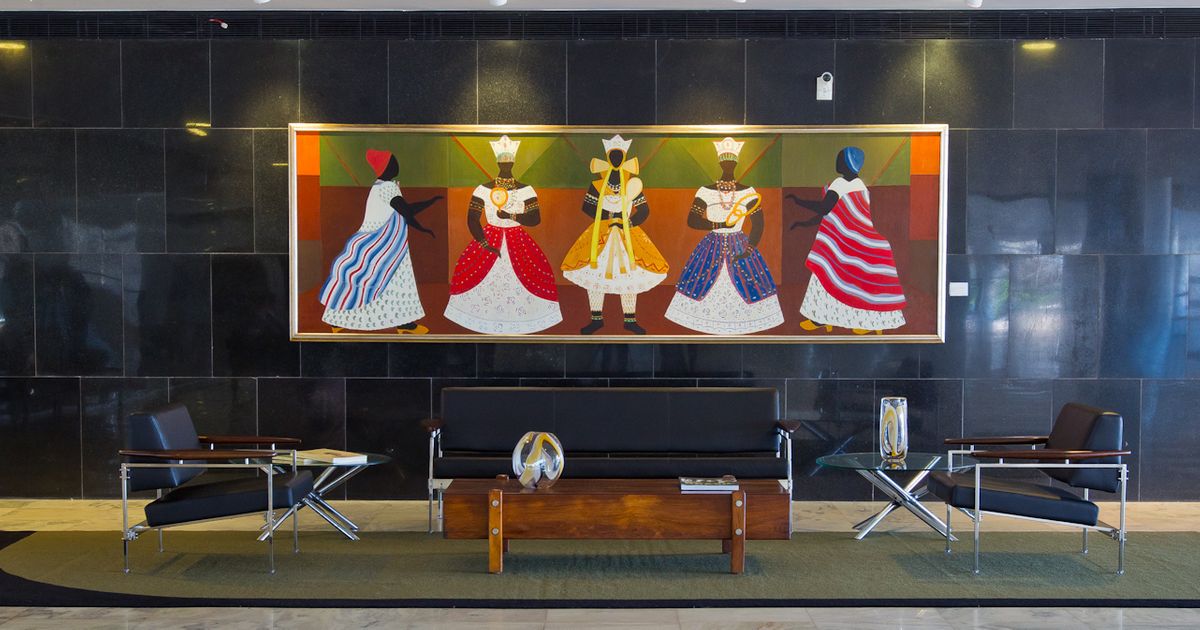Os Orixás (1966) by the Brazilian artist Djanira da Motta e Silva at the Palácio Planalto before it was removed
A painting depicting three deities of the Afro-Brazilian religion Candomblé has been removed from the Palácio Planalto, the official workplace of the Brazilian president in Brasília. The painting Os Orixás (1966) by the Brazilian artist Djanira da Motta e Silva, known as Djanira, has been moved to storage and replaced with a replica of the artists work called Praia de Nordeste (around mid-1960s)—a decision that has sparked debate around the historic intolerance of Afro-Brazilian religions and culture in the country.
In a statement to the magazine Piauí, which recently discovered the painting had been removed, the general secretariat of the president claims that Os Orixás was removed in December 2019 and that the decision was “a normal procedure that aims to rest and rotate artworks as a preventive conservation measure, in accordance to good museological practices”. However, a video recorded in June 2019 during a visit of Evangelical leaders to the Palácio Planalto reveals that the work was removed earlier.
The video also shows that the replica work, which holds no religious significance and depicts a colourful scene of fishermen on the beach, is mislabeled as Pescadores (1958). The secretariat confirmed that the piece is a “print plotted on canvas” that emulates an oil canvas, and acknowledges the error on the nameplate, which will be corrected.
Another curatorial paradox about the unannounced replacement of the work is that the original Praia de Nordeste is on view in a room on the third floor the Palácio Planalto, meaning that the building is now exhibiting the original work and the replica at the same time, and in places separated by just a few metres. There is no recorded administrative process that dealt with the replacement of Os Orixás.
President Jair Bolsonaro is alleged to have long planned to remove the piece at the request of his wife Michelle Bolsonaro, an Evangelical Christian. Controversy around the painting first came to light in December 2018, when the newspaper Folha de São Paulo reported that the Brazilian first lady planned to remove works with images of Catholic saints at the Palácio da Alvorada, the presidential home in Brasília, and that the painting Os Orixás was also of concern, according to three staff members at the Palácio Planalto.
The report also suggested that Os Orixás would be loaned to the Museum of Art of São Paulo Assis Chateaubriand (Masp) for a major travelling retrospective devoted to Djanira that was held in March last year. But in a statement to The Art Newspaper, a spokeswoman for the museum denied that the painting would be included in the exhibition, and that its deal with the government to acquire the work, which is estimated to be worth between 3m-4m reais, never materialised.
Bolsonaro addressed the issue in a live social media broadcast last year, stating that there was “no religious conflict”, and that such reports were “not productive” for the country. But the story served to underline the administrations treatment of marginalised groups and its attitude toward the arts sector, which has been hard hit since Bolsonaro took office and slashed the ministry of culture and federal funding for several cultural productions deemed to uphold non-conservative values.
Rogério Carvalho, who served as the curator of the Palácio Planalto and the Palácio da Alvorada in 2009 during the second term of the president Luiz Inácio Lula da Silva, tells UOLthat the governments explanation of rotating the works for conservation purposes is “absurd”, and that “government palaces are not museums”. He says there is no justification for replacing the work with a replica, and that the piece was in excellent condition and did not require conservation.
Carvalho adds that it was his teams decision to move Os Orixás from a less-visited room on the third floor of the palace to a place of “greater access to visitors” as a “sign of inclusion and acceptance of all religions”. He adds that the “state is secular, and if there is a saint or a crucifix iRead More – Source
[contf]
[contfnew]
the art news paper
[contfnewc]
[contfnewc]





